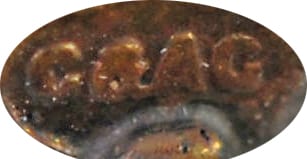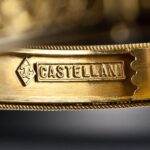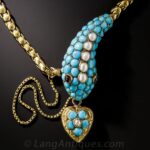(c.1860-1914)
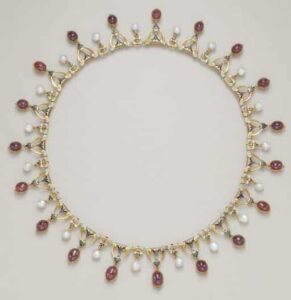
Photo Courtesy of Christie’s.
Carlo Giuliano (1831-1895) was an Italian goldsmith who moved to London with his wife and two sons c.1860. He established a workshop on Frith Street where his predominantly revivalist jewelry was created. This location did not have a showroom, Giuliano’s jewels were outsourced to various retailers in London’s West End. The firms of Hunt & Roskell, C.F. Hancock, and Robert Phillips were largely responsible for Giuliano’s success until he opened his own shop in 1874. Items produced for these retailers were sometimes “double-marked” with the C.G. Goldsmith’s Hall registered mark for Giuliano and an unregistered trademark applied as a plaque by the retailer.
Giuliano did not showcase his jewels under his own name at the Exposition Universelle in Paris, in 1867. His retail network of re-sellers included Giuliano’s work in their displays. Although he held no English Royal Warrants, Giuliano is believed to have been the creator of a pendant with black and white enamel made as a mourning piece for the Queen upon the death of Prince Alfred, Duke of Edinburgh and Saxe-Coburg-Gotha, son of Queen Victoria. King Edward VII was said to have been a regular patron and Queen Alexandra’s pearls were reputed to have been cleaned and restrung there. Empress Victoria of Prussia was also known to frequent the premises.
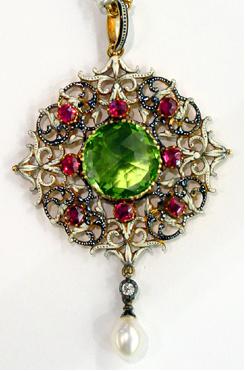
Influenced primarily by the Renaissance, Giuliano created very popular lozenge-shaped pendants with enamel work. Black and white enamel, in the style of French jewelers of the seventeenth century, was paired with diamonds in an exceedingly popular monochrome look. A fourth-century B.C. necklace from Melos suspending amphorae sold to the British Museum by Castellani was a direct influence on an Archaeological Revival necklace Giuliano created with a loop-in-loop chained ribbon suspending “cave pearls” topped to resemble amphorae. An Indian influence can be found in some of the multicolored champlevé enamel works created by Giuliano. While archeological and Renaissance inspirations were the firm’s “bread and butter” other popular themes of the day were largely passed over. Egyptian Revival and Oriental inspiration were not suited to Guiliano’s style.
As a revivalist jeweler, Giuliano often employed ancient techniques and tools in his work. Die-stamping was surprisingly not a new technique, Hellenistic goldsmiths used it and so did revivalists. The many amphorae necessary to complete a typical fringed necklace were made through the die-stamping process. The foundation of these necklaces were loop-in-loop chains, handcrafted for this purpose. Enamel techniques such as champlevé, basse-taille and en ronde bosse were widely used to decorate his jewels. Giuliano had a particular affinity for painted enamel and he used it on such large areas that a counter enamel was required to stabilize the piece in the kiln. He made good use of this broad expanse of plain enamel to flourish a complete signature.
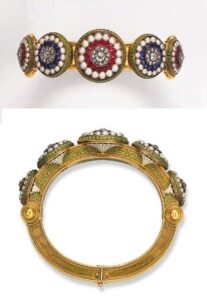
Carlo Giuliano’s ties to another Italian goldsmith in London during the same period, Castellani, are highly disputed. Some jewellery historians claim that Giuliano apprenticed with the firm and that he “accompanied Alessandro Castellini to London [in 1862] with the intention of managing the latter’s firm at 13 Frith Street.”1 Others claim that this connection “is entirely hypothetical, [and] in fact unlikely” as Giuliano is never mentioned in Augusto Castellani’s memoirs.2 Yet others suggest that Giuliano and Alessandro Castellani met each other in London and that Giuliano’s store, which he opened in 1874, was an outlet for pieces produced in Naples at Alessandro’s workshop.3
Upon his death in 1895, Carlo Giuliano’s will revealed several unusual bequests. A jewel valued at £50 for each of his loyal retail customers, seventeen grenaille works to the English Government and the South Kensington Museum (Victoria & Albert Museum) Director was to select enamel work from the shop’s stock, with a value of £200, to be put on display in a glass case near the tea room (from where they were stolen in 1899.) Carlo’s son, Carlo Joseph, inherited half the business along with his brother Arthur Alphonse. Going forward, jewelry created under the name Giuliano bore a mark with both sons’ initials, but it was Arthur who truly succeeded his father creatively. The firm remained viable until Arthur’s suicide in 1914 resulting in the closure of the business.R
Maker's Marks & Timeline
Giuliano
| Country | |
|---|---|
| City | London |
| Symbol | cartouche, frame, oval |
| Shape | cartouche, frame, oval |
| Era | e.1861 |
Specialties
- Renaissance Revival Style
- Lozenge-shaped Pendants
- Champlevé, Basse-Taille and en Ronde Bosse Enamel
- Naples born, emigrated to London c.1860.
1861
- Established business on Frith St.
1860-1874
- Outsourced to Hunt & Roskell, C.F. Hancock & Robert Phillips
1895
- Carlo Giuliano dies and sons Carlo Joseph and Arthur Alphonse ran the business until 1914
Related Reading
Sources
- Soros, Susan Weber & Stefanie Walker, ed. Castellani and Italian Archaeological Jewelry. New Haven: Yale University Press, 2004. ISBN 0300104618
- Munn, Geoffrey C. Castellani and Giuliano: Revivalist Jewellers of the 19th Century. New York: Rizzoli, 1983. ISBN 0847805271
- Ogden, Jack. ‘Revivers of the Lost Art: Alessandro Castellani and the Quest for Classical Precision. In Castellani and Italian Archaeological Jewelery, ed. Stefanie Walker Susan Weber Soros, 180-198. New Haven: Yale University Press, 2004. ISBN 0300104618
- Bennett, David & Daniela Mascetti. Understanding Jewellery. Suffolk, England: Antique Collectors’ Club, 1989. ISBN 1851494308(3rd edition, 2007)


